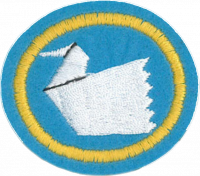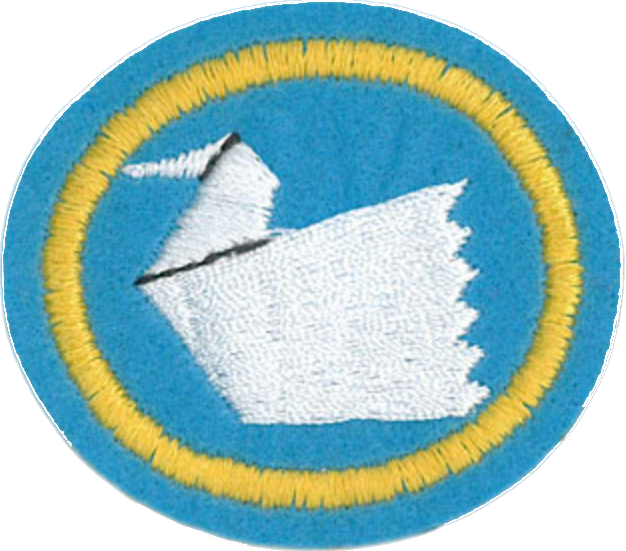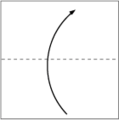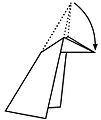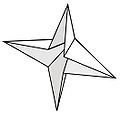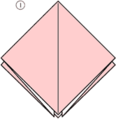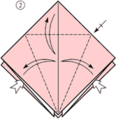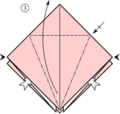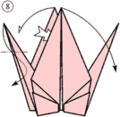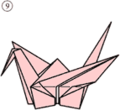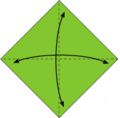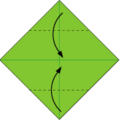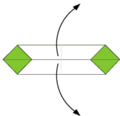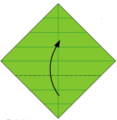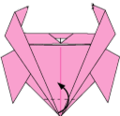Difference between revisions of "AY Honors/Origami/Answer Key/es"
m (Jomegat moved page Adventist Youth Honors Answer Book/Arts and Crafts/Origami/es to Especialidades JA/Origami/Respuestas without leaving a redirect) |
(Created page with "</noinclude>") |
||
| Line 1: | Line 1: | ||
| − | < | + | {{HonorSubpage}} |
| − | + | <section begin="Body" /> | |
| + | {{ansreq|page={{#titleparts:{{PAGENAME}}|2|1}}|num=1}} | ||
<noinclude></noinclude> | <noinclude></noinclude> | ||
| − | + | <!-- 1. ¿Qué es el Origami? ¿De dónde proviene? ¿Cómo es utilizado? ¿Cómo se desarrolló? --> | |
| − | |||
| − | |||
| − | |||
| − | |||
| − | |||
| − | |||
| − | |||
| − | |||
| − | |||
| − | |||
| − | |||
{{clear}} | {{clear}} | ||
| Line 21: | Line 11: | ||
{{clear}} | {{clear}} | ||
| − | ==2. | + | <noinclude></noinclude> |
| + | {{CloseReq}} <!-- 1 --> | ||
| + | {{ansreq|page={{#titleparts:{{PAGENAME}}|2|1}}|num=2}} | ||
| + | <noinclude><div lang="en" dir="ltr" class="mw-content-ltr"> | ||
| + | </noinclude> | ||
| + | <!-- 2. Identify the symbols for the following terms: --> | ||
| + | </div> | ||
| − | + | <div lang="en" dir="ltr" class="mw-content-ltr"> | |
| + | '''Note:''' Almost every origami book has basic instructions and a set of folding symbols. | ||
| + | </div> | ||
| − | == | + | <noinclude></noinclude> |
| + | {{ansreq|page={{#titleparts:{{PAGENAME}}|2|1}}|num=2a}} <!--T:8--> | ||
| + | <noinclude></noinclude> | ||
| − | == | + | <noinclude></noinclude> |
| + | {{CloseReq}} <!-- 2a --> | ||
| + | {{ansreq|page={{#titleparts:{{PAGENAME}}|2|1}}|num=2b}} <!--T:9--> | ||
| + | <noinclude></noinclude> | ||
| − | == | + | <noinclude></noinclude> |
| + | {{CloseReq}} <!-- 2b --> | ||
| + | {{ansreq|page={{#titleparts:{{PAGENAME}}|2|1}}|num=2c}} <!--T:10--> | ||
| + | <noinclude></noinclude> | ||
{{clear}} | {{clear}} | ||
| − | == | + | <noinclude></noinclude> |
| + | {{CloseReq}} <!-- 2c --> | ||
| + | {{ansreq|page={{#titleparts:{{PAGENAME}}|2|1}}|num=2d}} <!--T:12--> | ||
| + | <noinclude></noinclude> | ||
| − | == | + | <noinclude></noinclude> |
| + | {{CloseReq}} <!-- 2d --> | ||
| + | {{ansreq|page={{#titleparts:{{PAGENAME}}|2|1}}|num=2e}} <!--T:13--> | ||
| + | <noinclude></noinclude> | ||
| − | === | + | <div lang="en" dir="ltr" class="mw-content-ltr"> |
| + | <noinclude> | ||
| + | </div></noinclude> | ||
| + | {{CloseReq}} <!-- 2e --> | ||
| + | {{ansreq|page={{#titleparts:{{PAGENAME}}|2|1}}|num=2f}} <!--T:14--> | ||
| + | <noinclude><div lang="en" dir="ltr" class="mw-content-ltr"> | ||
| + | </noinclude> | ||
| + | </div> | ||
| − | === | + | <div lang="en" dir="ltr" class="mw-content-ltr"> |
| + | <noinclude> | ||
| + | </div></noinclude> | ||
| + | {{CloseReq}} <!-- 2f --> | ||
| + | {{ansreq|page={{#titleparts:{{PAGENAME}}|2|1}}|num=2g}} <!--T:15--> | ||
| + | <noinclude><div lang="en" dir="ltr" class="mw-content-ltr"> | ||
| + | </noinclude> | ||
| + | <gallery> | ||
| + | Image:YengeçAdım1.png|Example use of symbol | ||
| + | Image:YengeçAdım2.png|Example use of symbol | ||
| + | </gallery> | ||
| + | </div> | ||
| − | === | + | <div lang="en" dir="ltr" class="mw-content-ltr"> |
| + | <noinclude> | ||
| + | </div></noinclude> | ||
| + | {{CloseReq}} <!-- 2g --> | ||
| + | {{ansreq|page={{#titleparts:{{PAGENAME}}|2|1}}|num=2h}} <!--T:16--> | ||
| + | <noinclude><div lang="en" dir="ltr" class="mw-content-ltr"> | ||
| + | </noinclude> | ||
| + | <gallery> | ||
| + | Image:YengeçAdım7.png|Example use of symbol | ||
| + | </gallery> | ||
| + | </div> | ||
| − | === | + | <div lang="en" dir="ltr" class="mw-content-ltr"> |
| + | <noinclude> | ||
| + | </div></noinclude> | ||
| + | {{CloseReq}} <!-- 2h --> | ||
| + | {{ansreq|page={{#titleparts:{{PAGENAME}}|2|1}}|num=2i}} <!--T:17--> | ||
| + | <noinclude><div lang="en" dir="ltr" class="mw-content-ltr"> | ||
| + | </noinclude> | ||
| + | </div> | ||
| − | === | + | <div lang="en" dir="ltr" class="mw-content-ltr"> |
| + | <noinclude> | ||
| + | </div></noinclude> | ||
| + | {{CloseReq}} <!-- 2i --> | ||
| + | {{ansreq|page={{#titleparts:{{PAGENAME}}|2|1}}|num=2j}} <!--T:18--> | ||
| + | <noinclude><div lang="en" dir="ltr" class="mw-content-ltr"> | ||
| + | </noinclude> | ||
| + | </div> | ||
| − | + | <div lang="en" dir="ltr" class="mw-content-ltr"> | |
| + | Fold over and over symbol at http://www.oriland.com/oriversity/symbols/main.asp | ||
| + | </div> | ||
| − | === | + | <div lang="en" dir="ltr" class="mw-content-ltr"> |
| + | <noinclude> | ||
| + | </div></noinclude> | ||
| + | {{CloseReq}} <!-- 2j --> | ||
| + | {{ansreq|page={{#titleparts:{{PAGENAME}}|2|1}}|num=2k}} <!--T:20--> | ||
| + | <noinclude><div lang="en" dir="ltr" class="mw-content-ltr"> | ||
| + | </noinclude> | ||
| + | <gallery> | ||
| + | Image:Diyagram 11.gif|k. Turn model over | ||
| + | Image:YengeçAdım5.png|Example use of symbol | ||
| + | Image:YengeçAdım9.png|Example use of symbol | ||
| + | Image:YengeçAdım12.png|Example use of symbol | ||
| + | </gallery> | ||
| + | </div> | ||
| − | ==3. | + | <div lang="en" dir="ltr" class="mw-content-ltr"> |
| + | <noinclude> | ||
| + | </div></noinclude> | ||
| + | {{CloseReq}} <!-- 2k --> | ||
| + | {{CloseReq}} <!-- 2 --> | ||
| + | {{ansreq|page={{#titleparts:{{PAGENAME}}|2|1}}|num=3}} | ||
| + | <noinclude><div lang="en" dir="ltr" class="mw-content-ltr"> | ||
| + | </noinclude> | ||
| + | <!-- 3. Demonstrate folding the following folds: --> | ||
| + | </div> | ||
| − | === | + | <div lang="en" dir="ltr" class="mw-content-ltr"> |
| + | <noinclude> | ||
| + | </div></noinclude> | ||
| + | {{ansreq|page={{#titleparts:{{PAGENAME}}|2|1}}|num=3a}} <!--T:22--> | ||
| + | <noinclude><div lang="en" dir="ltr" class="mw-content-ltr"> | ||
| + | </noinclude> | ||
| + | *An outside reverse fold consists of two radial valley folds extending from a single point on a central fold and a reversal of the center fold on the affected end, all done simultaneously. | ||
| + | *An inside reverse fold consists of two radial mountain folds extending from a single point on a central fold, and a reversal of the central fold on the affected end, all done simultaneously. | ||
| + | </div> | ||
| − | + | <div lang="en" dir="ltr" class="mw-content-ltr"> | |
| + | <gallery> | ||
| + | Image:Inside-reverse-fold.jpg|Inside reverse fold | ||
| + | Image:Outside-reverse-fold.jpg|Outside reverse fold | ||
| + | </gallery> | ||
| + | </div> | ||
| − | === | + | <div lang="en" dir="ltr" class="mw-content-ltr"> |
| + | <noinclude> | ||
| + | </div></noinclude> | ||
| + | {{CloseReq}} <!-- 3a --> | ||
| + | {{ansreq|page={{#titleparts:{{PAGENAME}}|2|1}}|num=3b}} <!--T:24--> | ||
| + | <noinclude><div lang="en" dir="ltr" class="mw-content-ltr"> | ||
| + | </noinclude> | ||
| + | * A squash fold starts with a flap with at least two layers (for example, one flap of a waterbomb base). Make a radial fold from the closed point down the center of this flap. Open the flap and refold downward to make two adjacent flaps. | ||
| + | <gallery> | ||
| + | Image:Squash-fold.jpg|Squash fold applied to one flap of a waterbomb base | ||
| + | </gallery> | ||
| + | </div> | ||
| − | === | + | <div lang="en" dir="ltr" class="mw-content-ltr"> |
| + | <noinclude> | ||
| + | </div></noinclude> | ||
| + | {{CloseReq}} <!-- 3b --> | ||
| + | {{ansreq|page={{#titleparts:{{PAGENAME}}|2|1}}|num=3c}} <!--T:25--> | ||
| + | <noinclude><div lang="en" dir="ltr" class="mw-content-ltr"> | ||
| + | </noinclude> | ||
| + | * A petal fold starts with two connected flaps, each of which has at least two layers. (For example, two flaps of a preliminary base). The two flaps are attached to each other along a reference crease. Make two radial folds from the open point, so that the open edges lie along the reference crease. Unfold these two radial folds. Make another fold across the top connecting the ends of the creases to create a triangle of creases. Unfold this fold as well. Fold one layer of the open point upward and flatten it using the existing creases. A petal fold is equivalent to two side-by-side rabbit ears, which are connected along the reference crease. | ||
| + | <gallery> | ||
| + | Image:Petal-fold.svg|Petal fold on one half of a preliminary fold | ||
| + | </gallery> | ||
| + | </div> | ||
| − | === | + | <div lang="en" dir="ltr" class="mw-content-ltr"> |
| + | <noinclude> | ||
| + | </div></noinclude> | ||
| + | {{CloseReq}} <!-- 3c --> | ||
| + | {{ansreq|page={{#titleparts:{{PAGENAME}}|2|1}}|num=3d}} <!--T:26--> | ||
| + | <noinclude><div lang="en" dir="ltr" class="mw-content-ltr"> | ||
| + | </noinclude> | ||
| + | See example at http://www.folds.net/tutorial/folds/book/book_diagrams.html | ||
| + | </div> | ||
| − | === | + | <div lang="en" dir="ltr" class="mw-content-ltr"> |
| + | <noinclude> | ||
| + | </div></noinclude> | ||
| + | {{CloseReq}} <!-- 3d --> | ||
| + | {{ansreq|page={{#titleparts:{{PAGENAME}}|2|1}}|num=3e}} <!--T:27--> | ||
| + | <noinclude><div lang="en" dir="ltr" class="mw-content-ltr"> | ||
| + | </noinclude> | ||
| + | * The preliminary fold consists of two perpendicular diagonal mountain folds that bisect the corners of the square and two perpendicular valley folds that bisect the edges of the square. The paper is then collapsed to form a square shape with four isosceles-right triangular flaps. | ||
| + | <gallery> | ||
| + | Image:Preliminary-fold.svg|Preliminary fold | ||
| + | Image:Petal-fold.svg|Petal fold on one half of a preliminary fold | ||
| + | </gallery> | ||
| + | </div> | ||
| − | === | + | <div lang="en" dir="ltr" class="mw-content-ltr"> |
| + | <noinclude> | ||
| + | </div></noinclude> | ||
| + | {{CloseReq}} <!-- 3e --> | ||
| + | {{ansreq|page={{#titleparts:{{PAGENAME}}|2|1}}|num=3f}} <!--T:28--> | ||
| + | <noinclude><div lang="en" dir="ltr" class="mw-content-ltr"> | ||
| + | </noinclude> | ||
| + | * A blintz fold is made by folding the corners of a square into the center. This can be achieved with higher accuracy by folding and unfolding two reference creases through the center. | ||
| + | <gallery> | ||
| + | Image:Blintz-fold.jpg | ||
| + | </gallery> | ||
| + | </div> | ||
| − | ==4. | + | <div lang="en" dir="ltr" class="mw-content-ltr"> |
| + | <noinclude> | ||
| + | </div></noinclude> | ||
| + | {{CloseReq}} <!-- 3f --> | ||
| + | {{CloseReq}} <!-- 3 --> | ||
| + | {{ansreq|page={{#titleparts:{{PAGENAME}}|2|1}}|num=4}} | ||
| + | <noinclude><div lang="en" dir="ltr" class="mw-content-ltr"> | ||
| + | </noinclude> | ||
| + | <!-- 4. Demonstrate folding the following bases: --> | ||
| + | In origami, there is a series of several bases that many models are created with. In general, "base" refers to any folded paper that immediately precedes final folding and shaping of the model-to-be. | ||
| + | </div> | ||
| − | === | + | <div lang="en" dir="ltr" class="mw-content-ltr"> |
| + | <noinclude> | ||
| + | </div></noinclude> | ||
| + | {{ansreq|page={{#titleparts:{{PAGENAME}}|2|1}}|num=4a}} <!--T:30--> | ||
| + | <noinclude><div lang="en" dir="ltr" class="mw-content-ltr"> | ||
| + | </noinclude> | ||
| + | * The bird base, or crane base, consists of a preliminary fold with both the front and the back sides petal folded upward. | ||
| + | </div> | ||
| − | === | + | <div lang="en" dir="ltr" class="mw-content-ltr"> |
| + | <noinclude> | ||
| + | </div></noinclude> | ||
| + | {{CloseReq}} <!-- 4a --> | ||
| + | {{ansreq|page={{#titleparts:{{PAGENAME}}|2|1}}|num=4b}} <!--T:31--> | ||
| + | <noinclude><div lang="en" dir="ltr" class="mw-content-ltr"> | ||
| + | </noinclude> | ||
| + | * The waterbomb base consists of two perpendicular valley folds down the diagonals of the square and two perpendicular mountain folds down the center of the square. This crease pattern is then compressed to form the waterbomb base, which is an isosceles-right triangle with four isosceles-right triangular flaps. The waterbomb base is an inside-out preliminary fold. | ||
| + | <gallery> | ||
| + | Image:Water-bomb-base.jpg | ||
| + | </gallery> | ||
| + | </div> | ||
| − | === | + | <div lang="en" dir="ltr" class="mw-content-ltr"> |
| + | <noinclude> | ||
| + | </div></noinclude> | ||
| + | {{CloseReq}} <!-- 4b --> | ||
| + | {{ansreq|page={{#titleparts:{{PAGENAME}}|2|1}}|num=4c}} <!--T:32--> | ||
| + | <noinclude><div lang="en" dir="ltr" class="mw-content-ltr"> | ||
| + | </noinclude> | ||
| + | * The frog base starts with a waterbomb base or preliminary fold. All four flaps are squash-folded (the result is the same in either case), and then the corners are petal folded upward. | ||
| + | </div> | ||
| − | + | <div lang="en" dir="ltr" class="mw-content-ltr"> | |
| + | ===Other Bases=== | ||
| + | *The '''kite base''' is merely two valley folds that bring two adjacent edges of the square together to lie on the square's diagonal. | ||
| + | *The '''fish base''' consists of two radial folds against a diagonal reference crease on each of two opposite corners. The flaps that result on the other two corners are carefully folded downwards in the same direction. In other words, it consists of two side-by-side rabbit ears. | ||
| + | </div> | ||
| − | + | <div lang="en" dir="ltr" class="mw-content-ltr"> | |
| + | If a square is blintz folded, then a kite/fish/bird/frog base is folded, and the blintzed edges teased out and collapsed n a certain fashion, this is called a blintzed kite/fish/bird/frog/base, which doubles the complexity and adds more points and edges to the original kite/fish/bird/frog base, for a more complex model that requires more points. It's possible to double blintz for a double blintzed kite/fish/bird/frog base if needed. Theoretically an infinite number of blintzes could be performed to yield an infinitely complex multipointed base, but paper thickness restricts this to generally two blintzes. | ||
| + | </div> | ||
| − | + | <div lang="en" dir="ltr" class="mw-content-ltr"> | |
| + | <gallery> | ||
| + | Image:Fish-base.svg|Fish base | ||
| + | </gallery> | ||
| + | </div> | ||
| − | + | <div lang="en" dir="ltr" class="mw-content-ltr"> | |
| + | There is also the diamond base, the square base, the boat base, the pig base, the helmet base, the blintz base, and the organ base.😊 | ||
| + | </div> | ||
| − | ==5. | + | <div lang="en" dir="ltr" class="mw-content-ltr"> |
| + | <noinclude> | ||
| + | </div></noinclude> | ||
| + | {{CloseReq}} <!-- 4c --> | ||
| + | {{CloseReq}} <!-- 4 --> | ||
| + | {{ansreq|page={{#titleparts:{{PAGENAME}}|2|1}}|num=5}} | ||
| + | <noinclude><div lang="en" dir="ltr" class="mw-content-ltr"> | ||
| + | </noinclude> | ||
| + | <!-- 5. Do three of the following models: --> | ||
| + | </div> | ||
| − | === | + | <div lang="en" dir="ltr" class="mw-content-ltr"> |
| + | <noinclude> | ||
| + | </div></noinclude> | ||
| + | {{ansreq|page={{#titleparts:{{PAGENAME}}|2|1}}|num=5a}} <!--T:38--> | ||
| + | <noinclude><div lang="en" dir="ltr" class="mw-content-ltr"> | ||
| + | </noinclude> | ||
| + | {{#widget:YouTube|id=eEsx799dz8c}} | ||
| + | </div> | ||
| − | === | + | <div lang="en" dir="ltr" class="mw-content-ltr"> |
| + | <noinclude> | ||
| + | </div></noinclude> | ||
| + | {{CloseReq}} <!-- 5a --> | ||
| + | {{ansreq|page={{#titleparts:{{PAGENAME}}|2|1}}|num=5b}} <!--T:39--> | ||
| + | <noinclude><div lang="en" dir="ltr" class="mw-content-ltr"> | ||
| + | </noinclude> | ||
| + | {{#widget:YouTube|id=eGPK1vvdyLE}} | ||
| + | </div> | ||
| − | === | + | <div lang="en" dir="ltr" class="mw-content-ltr"> |
| + | <noinclude> | ||
| + | </div></noinclude> | ||
| + | {{CloseReq}} <!-- 5b --> | ||
| + | {{ansreq|page={{#titleparts:{{PAGENAME}}|2|1}}|num=5c}} <!--T:40--> | ||
| + | <noinclude><div lang="en" dir="ltr" class="mw-content-ltr"> | ||
| + | </noinclude> | ||
| + | {{#widget:YouTube|id=NqZ-p8UeEN8}} | ||
| + | </div> | ||
| − | === | + | <div lang="en" dir="ltr" class="mw-content-ltr"> |
| + | <noinclude> | ||
| + | </div></noinclude> | ||
| + | {{CloseReq}} <!-- 5c --> | ||
| + | {{ansreq|page={{#titleparts:{{PAGENAME}}|2|1}}|num=5d}} <!--T:41--> | ||
| + | <noinclude><div lang="en" dir="ltr" class="mw-content-ltr"> | ||
| + | </noinclude> | ||
| + | {{#widget:YouTube|id=VZB1CjudM88}} | ||
| + | </div> | ||
| − | === | + | <div lang="en" dir="ltr" class="mw-content-ltr"> |
| + | <noinclude> | ||
| + | </div></noinclude> | ||
| + | {{CloseReq}} <!-- 5d --> | ||
| + | {{ansreq|page={{#titleparts:{{PAGENAME}}|2|1}}|num=5e}} <!--T:42--> | ||
| + | <noinclude><div lang="en" dir="ltr" class="mw-content-ltr"> | ||
| + | </noinclude> | ||
| + | </div> | ||
| − | {{ | + | <div lang="en" dir="ltr" class="mw-content-ltr"> |
| + | {{#widget:YouTube|id=cZdO2e8K29o}} | ||
| + | </div> | ||
| − | ==6. | + | <div lang="en" dir="ltr" class="mw-content-ltr"> |
| + | <noinclude> | ||
| + | </div></noinclude> | ||
| + | {{CloseReq}} <!-- 5e --> | ||
| + | {{CloseReq}} <!-- 5 --> | ||
| + | {{ansreq|page={{#titleparts:{{PAGENAME}}|2|1}}|num=6}} | ||
| + | <noinclude><div lang="en" dir="ltr" class="mw-content-ltr"> | ||
| + | </noinclude> | ||
| + | <!-- 6. Choose three of the following models to fold or select similar models from Origami books: --> | ||
| + | Here's a paper rose from WikiHow: | ||
| + | * http://www.wikihow.com/Fold-a-Paper-Rose | ||
| + | </div> | ||
| − | === | + | <div lang="en" dir="ltr" class="mw-content-ltr"> |
| + | <noinclude> | ||
| + | </div></noinclude> | ||
| + | {{ansreq|page={{#titleparts:{{PAGENAME}}|2|1}}|num=6a}} <!--T:45--> | ||
| + | <noinclude><div lang="en" dir="ltr" class="mw-content-ltr"> | ||
| + | </noinclude> | ||
| + | Here are a couple of links to WikiHow for making a jumping frog: | ||
| + | * http://www.wikihow.com/Make-an-Origami-Jumping-Frog | ||
| + | * http://www.wikihow.com/Make-an-Origami-Jumping-Frog-from-an-Index-Card | ||
| + | </div> | ||
| − | === | + | <div lang="en" dir="ltr" class="mw-content-ltr"> |
| + | <noinclude> | ||
| + | </div></noinclude> | ||
| + | {{CloseReq}} <!-- 6a --> | ||
| + | {{ansreq|page={{#titleparts:{{PAGENAME}}|2|1}}|num=6b}} <!--T:46--> | ||
| + | <noinclude><div lang="en" dir="ltr" class="mw-content-ltr"> | ||
| + | </noinclude> | ||
| + | {{#widget:YouTube|id=mkbTcchiaO4}} | ||
| + | </div> | ||
| − | === | + | <div lang="en" dir="ltr" class="mw-content-ltr"> |
| + | <noinclude> | ||
| + | </div></noinclude> | ||
| + | {{CloseReq}} <!-- 6b --> | ||
| + | {{ansreq|page={{#titleparts:{{PAGENAME}}|2|1}}|num=6c}} <!--T:47--> | ||
| + | <noinclude><div lang="en" dir="ltr" class="mw-content-ltr"> | ||
| + | </noinclude> | ||
| + | {{#widget:YouTube|id=BM6G_QLxkCE}} | ||
| + | {{#widget:YouTube|id=MIKUb40f2G4}} | ||
| + | {{#widget:YouTube|id=ld_k-mVwHW0}} | ||
| + | </div> | ||
| − | === | + | <div lang="en" dir="ltr" class="mw-content-ltr"> |
| + | <noinclude> | ||
| + | </div></noinclude> | ||
| + | {{CloseReq}} <!-- 6c --> | ||
| + | {{ansreq|page={{#titleparts:{{PAGENAME}}|2|1}}|num=6d}} <!--T:48--> | ||
| + | <noinclude><div lang="en" dir="ltr" class="mw-content-ltr"> | ||
| + | </noinclude> | ||
| + | {{#widget:YouTube|id=QsMm6QGsVgM}} | ||
| + | {{#widget:YouTube|id=Std9WIlXTlQ}} | ||
| + | {{#widget:YouTube|id=K64df5dnc0Y}} | ||
| + | </div> | ||
| − | === | + | <div lang="en" dir="ltr" class="mw-content-ltr"> |
| + | <noinclude> | ||
| + | </div></noinclude> | ||
| + | {{CloseReq}} <!-- 6d --> | ||
| + | {{ansreq|page={{#titleparts:{{PAGENAME}}|2|1}}|num=6e}} <!--T:49--> | ||
| + | <noinclude><div lang="en" dir="ltr" class="mw-content-ltr"> | ||
| + | </noinclude> | ||
| + | {{#widget:YouTube|id=T03pacI9vRE}} | ||
| + | </div> | ||
| − | === | + | <div lang="en" dir="ltr" class="mw-content-ltr"> |
| + | <noinclude> | ||
| + | </div></noinclude> | ||
| + | {{CloseReq}} <!-- 6e --> | ||
| + | {{ansreq|page={{#titleparts:{{PAGENAME}}|2|1}}|num=6f}} <!--T:50--> | ||
| + | <noinclude><div lang="en" dir="ltr" class="mw-content-ltr"> | ||
| + | </noinclude> | ||
| + | {{#widget:YouTube|id=LcHbptVyjtY}} | ||
| + | {{#widget:YouTube|id=-KLwuhLcBxo}} | ||
| + | </div> | ||
| − | === | + | <div lang="en" dir="ltr" class="mw-content-ltr"> |
| + | <noinclude> | ||
| + | </div></noinclude> | ||
| + | {{CloseReq}} <!-- 6f --> | ||
| + | {{ansreq|page={{#titleparts:{{PAGENAME}}|2|1}}|num=6g}} <!--T:51--> | ||
| + | <noinclude><div lang="en" dir="ltr" class="mw-content-ltr"> | ||
| + | </noinclude> | ||
| + | {{#widget:YouTube|id=tOEhgJ_zPxg}} | ||
| + | {{#widget:YouTube|id=Lc-P2xOZHKA}} | ||
| + | {{#widget:YouTube|id=m5A4y7CoeKc}} | ||
| + | {{#widget:YouTube|id=_3t0Jx63GJk}} | ||
| + | </div> | ||
| − | ==7. | + | <div lang="en" dir="ltr" class="mw-content-ltr"> |
| + | <noinclude> | ||
| + | </div></noinclude> | ||
| + | {{CloseReq}} <!-- 6g --> | ||
| + | {{CloseReq}} <!-- 6 --> | ||
| + | {{ansreq|page={{#titleparts:{{PAGENAME}}|2|1}}|num=7}} | ||
| + | <noinclude><div lang="en" dir="ltr" class="mw-content-ltr"> | ||
| + | </noinclude> | ||
| + | <!-- 7. Fold one model of your choice from memory from requirement 5 or 6. --> | ||
| + | I find the boat the easiest. | ||
| + | </div> | ||
| − | ==8. | + | <div lang="en" dir="ltr" class="mw-content-ltr"> |
| + | <noinclude> | ||
| + | </div></noinclude> | ||
| + | {{CloseReq}} <!-- 7 --> | ||
| + | {{ansreq|page={{#titleparts:{{PAGENAME}}|2|1}}|num=8}} | ||
| + | <noinclude><div lang="en" dir="ltr" class="mw-content-ltr"> | ||
| + | </noinclude> | ||
| + | <!-- 8. Illustrate a Bible story using several Origami models. --> | ||
| + | {{covid|tip=After you fold the models, you can illustrate by sharing with your family.}} | ||
| + | * Noah: ark (house on boat?) & bird | ||
| + | * Creation (you choose a variety of animals and make a male and female of each) | ||
| + | * Daniel's Lions | ||
| + | * Jesus' Parable of the lost sheep (you might NOT want to make 100 sheep, so think carefully through implementation). Rocks and bushes are foldable items and might privide a place to "hide" the sheep that the shepherd is finding. | ||
| + | * The four beasts of Daniel 7 (for advanced folders!) | ||
| + | *Zechariah 6:1-4 Horses and chariots. (for intermediant folders) | ||
| + | </div> | ||
| − | {{ | + | <div lang="en" dir="ltr" class="mw-content-ltr"> |
| + | <noinclude> | ||
| + | </div></noinclude> | ||
| + | {{CloseReq}} <!-- 8 --> | ||
| + | <noinclude><div lang="en" dir="ltr" class="mw-content-ltr"> | ||
| + | </noinclude> | ||
| + | ==Other== | ||
| + | Found these images, but they are not #5 or #6 above | ||
| + | </div> | ||
| − | + | <div lang="en" dir="ltr" class="mw-content-ltr"> | |
| + | <gallery> | ||
| + | Image:KuşAdım1.png | ||
| + | Image:KuşAdım2.png | ||
| + | Image:KuşAdım3.png | ||
| + | Image:KuşAdım4.png | ||
| + | Image:KuşAdım5.png | ||
| + | Image:KuşAdım6.png | ||
| + | Image:KuşAdım7.png | ||
| + | Image:KuşAdım8.png | ||
| + | Image:KuşAdım9.png | ||
| + | </gallery> | ||
| + | </div> | ||
| − | + | <div lang="en" dir="ltr" class="mw-content-ltr"> | |
| + | <gallery> | ||
| + | Image:YılanAdım1.png | ||
| + | Image:YılanAdım2.png | ||
| + | Image:YılanAdım3.png | ||
| + | Image:YılanAdım4.png | ||
| + | Image:YılanAdım5.png | ||
| + | Image:YılanAdım6.png | ||
| + | Image:YılanAdım7.png | ||
| + | Image:YılanAdım8.png | ||
| + | Image:YılanAdım9.png | ||
| + | </gallery> | ||
| + | </div> | ||
| − | + | <div lang="en" dir="ltr" class="mw-content-ltr"> | |
| + | <gallery> | ||
| + | Image:YengeçAdım1.png | ||
| + | Image:YengeçAdım2.png | ||
| + | Image:YengeçAdım3.png | ||
| + | Image:YengeçAdım4.png | ||
| + | Image:YengeçAdım5.png | ||
| + | Image:YengeçAdım6.png | ||
| + | Image:YengeçAdım7.png | ||
| + | Image:YengeçAdım8.png | ||
| + | Image:YengeçAdım9.png | ||
| + | Image:YengeçAdım10.png | ||
| + | Image:YengeçAdım11.png | ||
| + | Image:YengeçAdım12.png | ||
| + | Image:YengeçAdım13.png | ||
| + | </gallery> | ||
| + | </div> | ||
| − | == | + | <div lang="en" dir="ltr" class="mw-content-ltr"> |
| + | ==References== <!-- T:References --> | ||
| + | * | ||
| + | </div> | ||
| − | [[Category:Adventist Youth Honors Answer Book | + | <div lang="en" dir="ltr" class="mw-content-ltr"> |
| − | <noinclude></noinclude> | + | [[Category:Adventist Youth Honors Answer Book|{{SUBPAGENAME}}]] |
| + | <noinclude> | ||
| + | </div></noinclude> | ||
| + | {{CloseHonorPage}} | ||
Revision as of 13:14, 3 May 2021
1
2
Note: Almost every origami book has basic instructions and a set of folding symbols.
2a
2b
2c
2d
2e
2f
2g
2h
2i
2j
2k
3
3a
- An outside reverse fold consists of two radial valley folds extending from a single point on a central fold and a reversal of the center fold on the affected end, all done simultaneously.
- An inside reverse fold consists of two radial mountain folds extending from a single point on a central fold, and a reversal of the central fold on the affected end, all done simultaneously.
3b
- A squash fold starts with a flap with at least two layers (for example, one flap of a waterbomb base). Make a radial fold from the closed point down the center of this flap. Open the flap and refold downward to make two adjacent flaps.
3c
- A petal fold starts with two connected flaps, each of which has at least two layers. (For example, two flaps of a preliminary base). The two flaps are attached to each other along a reference crease. Make two radial folds from the open point, so that the open edges lie along the reference crease. Unfold these two radial folds. Make another fold across the top connecting the ends of the creases to create a triangle of creases. Unfold this fold as well. Fold one layer of the open point upward and flatten it using the existing creases. A petal fold is equivalent to two side-by-side rabbit ears, which are connected along the reference crease.
3d
See example at http://www.folds.net/tutorial/folds/book/book_diagrams.html
3e
- The preliminary fold consists of two perpendicular diagonal mountain folds that bisect the corners of the square and two perpendicular valley folds that bisect the edges of the square. The paper is then collapsed to form a square shape with four isosceles-right triangular flaps.
3f
- A blintz fold is made by folding the corners of a square into the center. This can be achieved with higher accuracy by folding and unfolding two reference creases through the center.
4
In origami, there is a series of several bases that many models are created with. In general, "base" refers to any folded paper that immediately precedes final folding and shaping of the model-to-be.
4a
- The bird base, or crane base, consists of a preliminary fold with both the front and the back sides petal folded upward.
4b
- The waterbomb base consists of two perpendicular valley folds down the diagonals of the square and two perpendicular mountain folds down the center of the square. This crease pattern is then compressed to form the waterbomb base, which is an isosceles-right triangle with four isosceles-right triangular flaps. The waterbomb base is an inside-out preliminary fold.
4c
- The frog base starts with a waterbomb base or preliminary fold. All four flaps are squash-folded (the result is the same in either case), and then the corners are petal folded upward.
Other Bases
- The kite base is merely two valley folds that bring two adjacent edges of the square together to lie on the square's diagonal.
- The fish base consists of two radial folds against a diagonal reference crease on each of two opposite corners. The flaps that result on the other two corners are carefully folded downwards in the same direction. In other words, it consists of two side-by-side rabbit ears.
If a square is blintz folded, then a kite/fish/bird/frog base is folded, and the blintzed edges teased out and collapsed n a certain fashion, this is called a blintzed kite/fish/bird/frog/base, which doubles the complexity and adds more points and edges to the original kite/fish/bird/frog base, for a more complex model that requires more points. It's possible to double blintz for a double blintzed kite/fish/bird/frog base if needed. Theoretically an infinite number of blintzes could be performed to yield an infinitely complex multipointed base, but paper thickness restricts this to generally two blintzes.
There is also the diamond base, the square base, the boat base, the pig base, the helmet base, the blintz base, and the organ base.😊
5
5a
5b
5c
5d
5e
6
Here's a paper rose from WikiHow:
6a
Here are a couple of links to WikiHow for making a jumping frog:
6b
6c
6d
6e
6f
6g
7
I find the boat the easiest.
8
| Tip for earning from home during the pandemic | |
| After you fold the models, you can illustrate by sharing with your family. |
- Noah: ark (house on boat?) & bird
- Creation (you choose a variety of animals and make a male and female of each)
- Daniel's Lions
- Jesus' Parable of the lost sheep (you might NOT want to make 100 sheep, so think carefully through implementation). Rocks and bushes are foldable items and might privide a place to "hide" the sheep that the shepherd is finding.
- The four beasts of Daniel 7 (for advanced folders!)
- Zechariah 6:1-4 Horses and chariots. (for intermediant folders)
Other
Found these images, but they are not #5 or #6 above
